Pan Tang
MicroRCA-Agent: Microservice Root Cause Analysis Method Based on Large Language Model Agents
Sep 19, 2025Abstract:This paper presents MicroRCA-Agent, an innovative solution for microservice root cause analysis based on large language model agents, which constructs an intelligent fault root cause localization system with multimodal data fusion. The technical innovations are embodied in three key aspects: First, we combine the pre-trained Drain log parsing algorithm with multi-level data filtering mechanism to efficiently compress massive logs into high-quality fault features. Second, we employ a dual anomaly detection approach that integrates Isolation Forest unsupervised learning algorithms with status code validation to achieve comprehensive trace anomaly identification. Third, we design a statistical symmetry ratio filtering mechanism coupled with a two-stage LLM analysis strategy to enable full-stack phenomenon summarization across node-service-pod hierarchies. The multimodal root cause analysis module leverages carefully designed cross-modal prompts to deeply integrate multimodal anomaly information, fully exploiting the cross-modal understanding and logical reasoning capabilities of large language models to generate structured analysis results encompassing fault components, root cause descriptions, and reasoning trace. Comprehensive ablation studies validate the complementary value of each modal data and the effectiveness of the system architecture. The proposed solution demonstrates superior performance in complex microservice fault scenarios, achieving a final score of 50.71. The code has been released at: https://github.com/tangpan360/MicroRCA-Agent.
Empirical Study on Near-Field and Spatial Non-Stationarity Modeling for THz XL-MIMO Channel in Indoor Scenario
May 14, 2025Abstract:Terahertz (THz) extremely large-scale MIMO (XL-MIMO) is considered a key enabling technology for 6G and beyond due to its advantages such as wide bandwidth and high beam gain. As the frequency and array size increase, users are more likely to fall within the near-field (NF) region, where the far-field plane-wave assumption no longer holds. This also introduces spatial non-stationarity (SnS), as different antenna elements observe distinct multipath characteristics. Therefore, this paper proposes a THz XL-MIMO channel model that accounts for both NF propagation and SnS, validated using channel measurement data. In this work, we first conduct THz XL-MIMO channel measurements at 100 GHz and 132 GHz using 301- and 531-element ULAs in indoor environments, revealing pronounced NF effects characterized by nonlinear inter-element phase variations, as well as element-dependent delay and angle shifts. Moreover, the SnS phenomenon is observed, arising not only from blockage but also from inconsistent reflection or scattering. Based on these observations, a hybrid NF channel modeling approach combining the scatterer-excited point-source model and the specular reflection model is proposed to capture nonlinear phase variation. For SnS modeling, amplitude attenuation factors (AAFs) are introduced to characterize the continuous variation of path power across the array. By analyzing the statistical distribution and spatial autocorrelation properties of AAFs, a statistical rank-matching-based method is proposed for their generation. Finally, the model is validated using measured data. Evaluation across metrics such as entropy capacity, condition number, spatial correlation, channel gain, Rician K-factor, and RMS delay spread confirms that the proposed model closely aligns with measurements and effectively characterizes the essential features of THz XL-MIMO channels.
High-Resolution Multipath Angle Estimation Based on Power-Angle-Delay Profile for Directional Scanning Sounding
Apr 17, 2025Abstract:Directional scanning sounding (DSS) has become widely adopted for high-frequency channel measurements because it effectively compensates for severe path loss. However, the resolution of existing multipath component (MPC) angle estimation methods is constrained by the DSS angle sampling interval. Therefore, this communication proposes a high-resolution MPC angle estimation method based on power-angle-delay profile (PADP) for DSS. By exploiting the mapping relationship between the power difference of adjacent angles in the PADP and MPC offset angle, the resolution of MPC angle estimation is refined, significantly enhancing the accuracy of MPC angle and amplitude estimation without increasing measurement complexity. Numerical simulation results demonstrate that the proposed method reduces the mean squared estimation errors of angle and amplitude by one order of magnitude compared to traditional omnidirectional synthesis methods. Furthermore, the estimation errors approach the Cram\'er-Rao Lower Bounds (CRLBs) derived for wideband DSS, thereby validating its superior performance in MPC angle and amplitude estimation. Finally, experiments conducted in an indoor scenario at 37.5 GHz validate the excellent performance of the proposed method in practical applications.
A Survey of New Mid-Band/FR3 for 6G: Channel Measurement, Characterization and Modeling in Outdoor Environment
Apr 09, 2025Abstract:The new mid-band (6-24 GHz) has attracted significant attention from both academia and industry, which is the spectrum with continuous bandwidth that combines the coverage benefits of low frequency with the capacity advantages of high frequency. Since outdoor environments represent the primary application scenario for mobile communications, this paper presents the first comprehensive review and summary of multi-scenario and multi-frequency channel characteristics based on extensive outdoor new mid-band channel measurement data, including UMa, UMi, and O2I. Specifically, a survey of the progress of the channel characteristics is presented, such as path loss, delay spread, angular spread, channel sparsity, capacity and near-field spatial non-stationary characteristics. Then, considering that satellite communication will be an important component of future communication systems, we examine the impact of clutter loss in air-ground communications. Our analysis of the frequency dependence of mid-band clutter loss suggests that its impact is not significant. Additionally, given that penetration loss is frequency-dependent, we summarize its variation within the FR3 band. Based on experimental results, comparisons with the standard model reveal that while the 3GPP TR 38.901 model remains a useful reference for penetration loss in wood and glass, it shows significant deviations for concrete and glass, indicating the need for further refinement. In summary, the findings of this survey provide both empirical data and theoretical support for the deployment of mid-band in future communication systems, as well as guidance for optimizing mid-band base station deployment in the outdoor environment. This survey offers the reference for improving standard models and advancing channel modeling.
Homophily-aware Heterogeneous Graph Contrastive Learning
Jan 15, 2025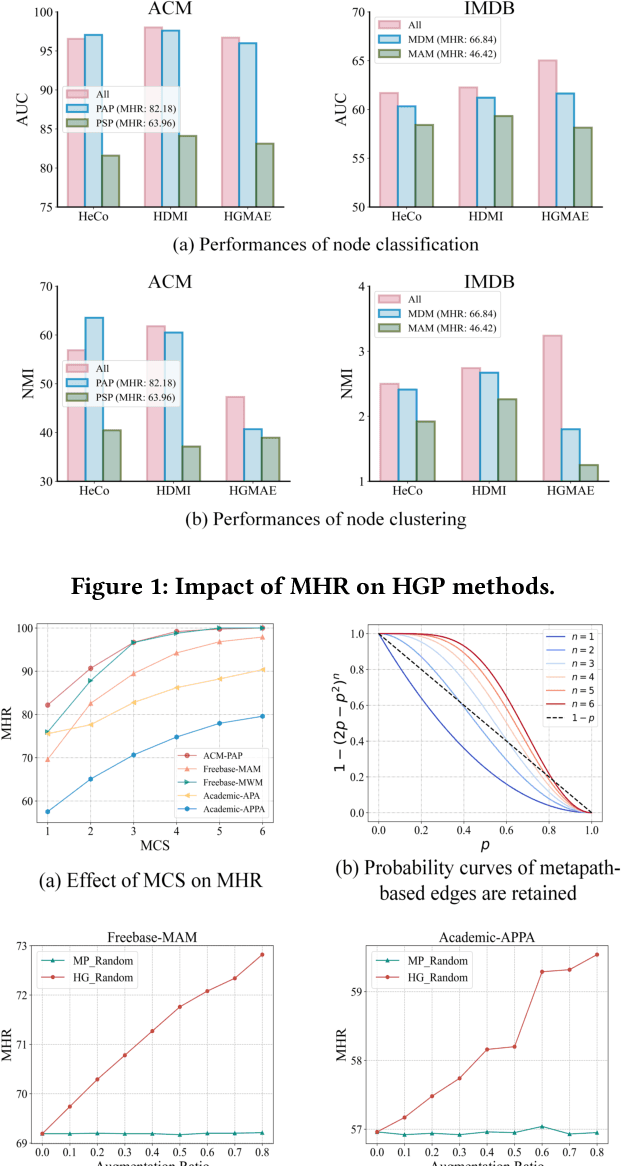
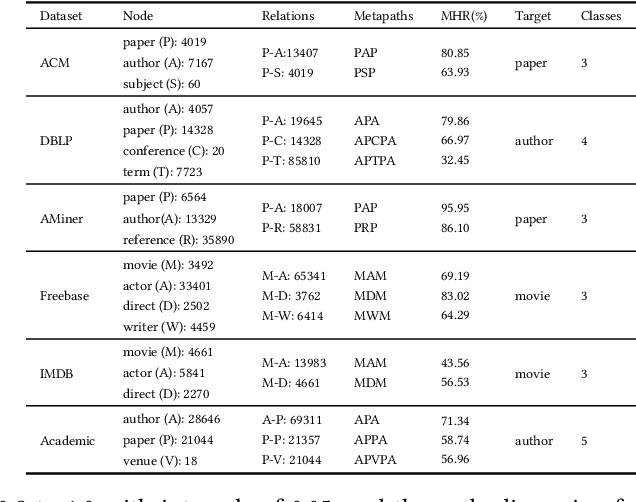
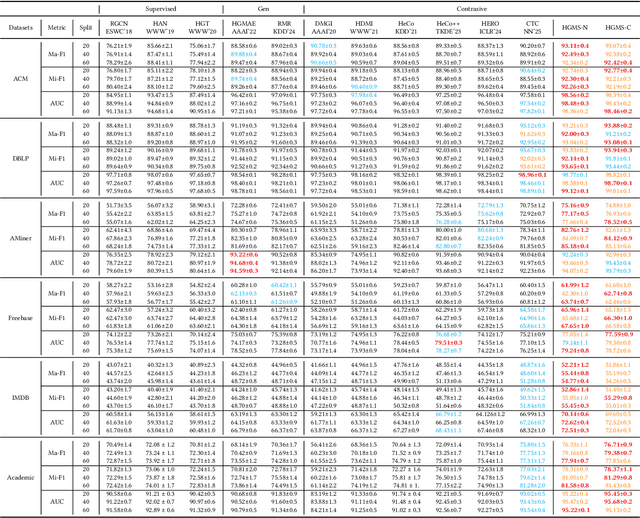
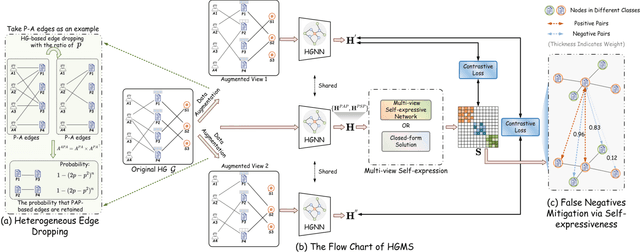
Abstract:Heterogeneous graph pre-training (HGP) has demonstrated remarkable performance across various domains. However, the issue of heterophily in real-world heterogeneous graphs (HGs) has been largely overlooked. To bridge this research gap, we proposed a novel heterogeneous graph contrastive learning framework, termed HGMS, which leverages connection strength and multi-view self-expression to learn homophilous node representations. Specifically, we design a heterogeneous edge dropping augmentation strategy that enhances the homophily of augmented views. Moreover, we introduce a multi-view self-expressive learning method to infer the homophily between nodes. In practice, we develop two approaches to solve the self-expressive matrix. The solved self-expressive matrix serves as an additional augmented view to provide homophilous information and is used to identify false negatives in contrastive loss. Extensive experimental results demonstrate the superiority of HGMS across different downstream tasks.
Experimental Analysis and Modeling of Penetration Loss for Building Materials in FR1 and FR3 bands
Dec 11, 2024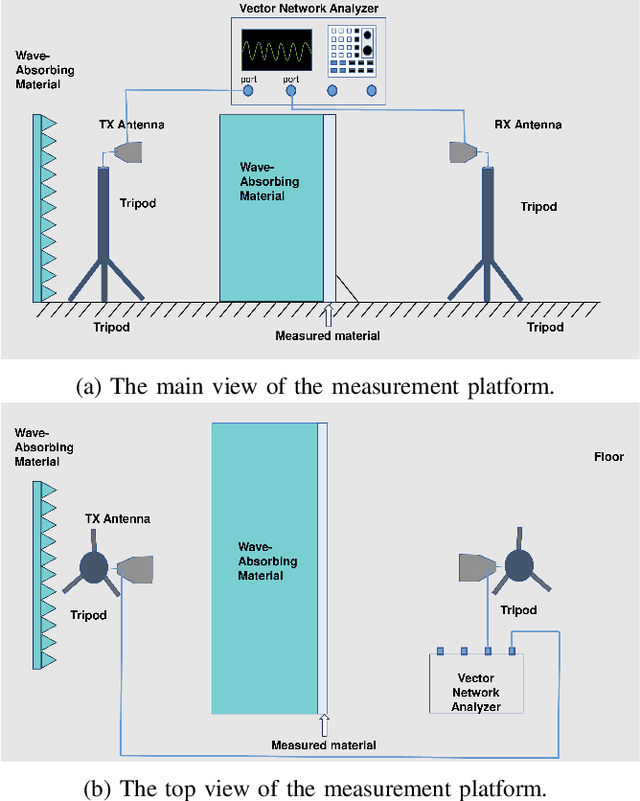
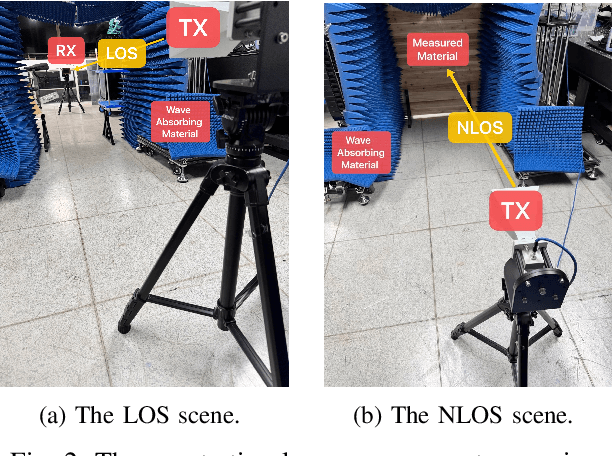
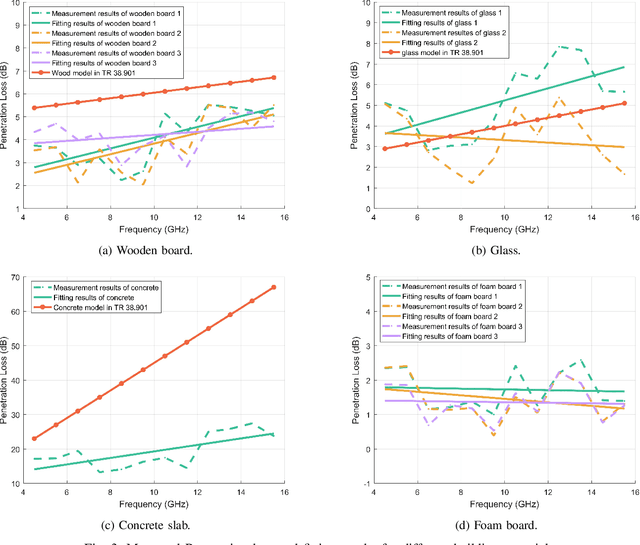
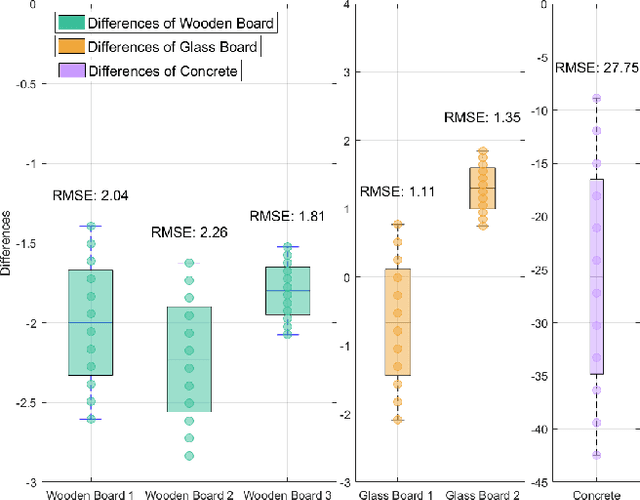
Abstract:This study focuses on analysis and modeling of the penetration loss of typical building materials in the FR1 (450 MHz-6 GHz) and FR3 (7-24 GHz) bands based on experimental measurements. Firstly, we measure the penetration loss characteristics of four different typical building materials from 4 to 16 GHz, including wood, glass, foam and concrete, by using a penetration loss measurement platform based on the vector network analyzer (VNA). Next, we analyze the frequency dependence and thickness dependence of penetration loss. Finally, the linear model is applied to fit the curve of the measured penetration loss, and new model parameters for the penetration loss of different building materials are given, which are compared with that in the third generation partnership project (3GPP) technical report (TR) 38.901. The analysis results and new model parameters may provides insight into understanding propagation characteristics in FR1 and FR3 bands and 3GPP channel model standardisation.
Environment Reconstruction with Multi-targets Reflectors-merged Sensing Method Based on THz Single-sided Channel Characteristics
Dec 05, 2024Abstract:Terahertz (THz) integrated sensing and communication (ISAC) holds the potential to achieve high data rates and high-resolution sensing. Reconstructing the propagation environment is a vital step for THz ISAC, as it enhances the predictability of the communication channel to reduce communication overhead. In this letter, we propose an environment reconstruction methodology (ERM) merging reflectors of multi-targets based on THz single-sided channel small-scale characteristics. In this method, the inclination and position of tiny reflection faces of one single multi-path (MPC) are initially detected by double-triangle equations based on Snells law and geometry properties. Then, those reflection faces of multi-target MPCs, which are filtrated as available and one-order reflection MPCs, are globally merged to accurately reconstruct the entire propagation environment. The ERM is capable of operating with only small-scale parameters of receiving MPC. Subsequently, we validate our ERM through two experiments: bi-static ray-tracing simulations in an L-shaped room and channel measurements in an urban macrocellular (UMa) scenario in THz bands. The validation results demonstrate a small deviation of 0.03 m between the sensing outcomes and the predefined reflectors in the ray-tracing simulation and a small sensing root-mean-square error of 1.28 m and 0.45 m in line-of-sight and non-line-of-sight cases respectively based on channel measurements. Overall, this work is valuable for designing THz communication systems and facilitating the application of THz ISAC communication techniques.
Empirical Studies of Propagation Characteristics and Modeling Based on XL-MIMO Channel Measurement: From Far-Field to Near-Field
Apr 26, 2024Abstract:In the sixth-generation (6G), the extremely large-scale multiple-input-multiple-output (XL-MIMO) is considered a promising enabling technology. With the further expansion of array element number and frequency bands, near-field effects will be more likely to occur in 6G communication systems. The near-field radio communications (NFRC) will become crucial in 6G communication systems. It is known that the channel research is very important for the development and performance evaluation of the communication systems. In this paper, we will systematically investigate the channel measurements and modeling for the emerging NFRC. First, the principle design of massive MIMO channel measurement platform are solved. Second, an indoor XL-MIMO channel measurement campaign with 1600 array elements is conducted, and the channel characteristics are extracted and validated in the near-field region. Then, the outdoor XL-MIMO channel measurement campaign with 320 array elements is conducted, and the channel characteristics are extracted and modeled from near-field to far-field (NF-FF) region. The spatial non-stationary characteristics of angular spread at the transmitting end are more important in modeling. We hope that this work will give some reference to the near-field and far-field research for 6G.
Channel Measurement, Modeling, and Simulation for 6G: A Survey and Tutorial
May 26, 2023Abstract:Technology research and standardization work of sixth generation (6G) has been carried out worldwide. Channel research is the prerequisite of 6G technology evaluation and optimization. This paper presents a survey and tutorial on channel measurement, modeling, and simulation for 6G. We first highlight the challenges of channel for 6G systems, including higher frequency band, extremely large antenna array, new technology combinations, and diverse application scenarios. A review of channel measurement and modeling for four possible 6G enabling technologies is then presented, i.e., terahertz communication, massive multiple-input multiple-output communication, joint communication and sensing, and reconfigurable intelligent surface. Finally, we introduce a 6G channel simulation platform and provide examples of its implementation. The goal of this paper is to help both professionals and non-professionals know the progress of 6G channel research, understand the 6G channel model, and use it for 6G simulation.
3GPP-Like THz Channel Modeling for Indoor Office and Urban Microcellular Scenarios
May 24, 2023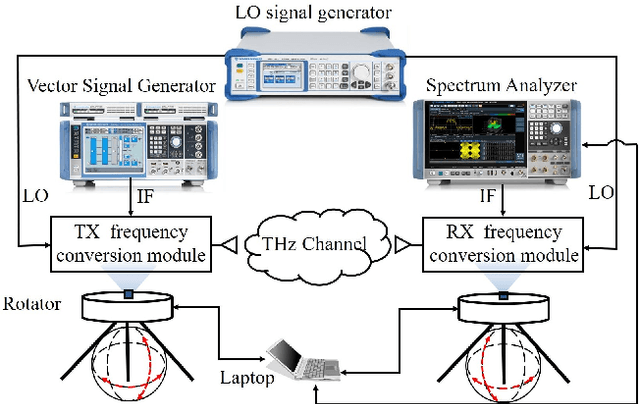
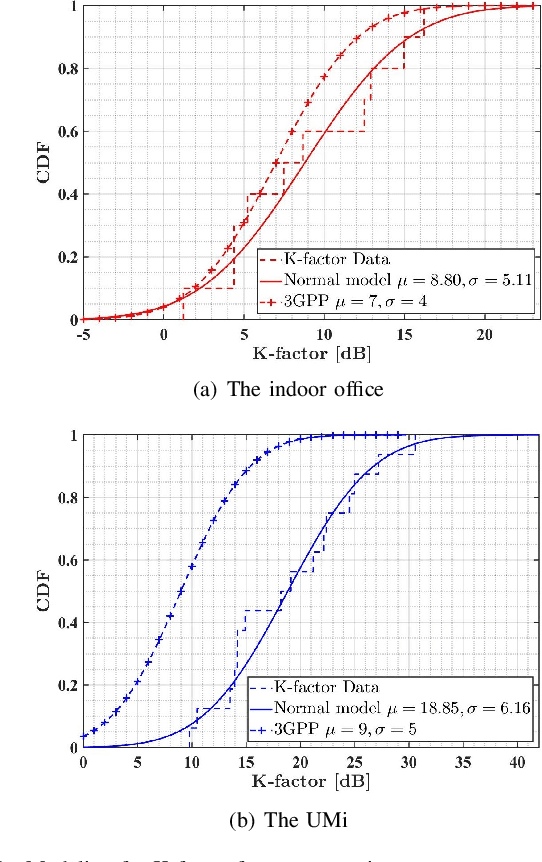
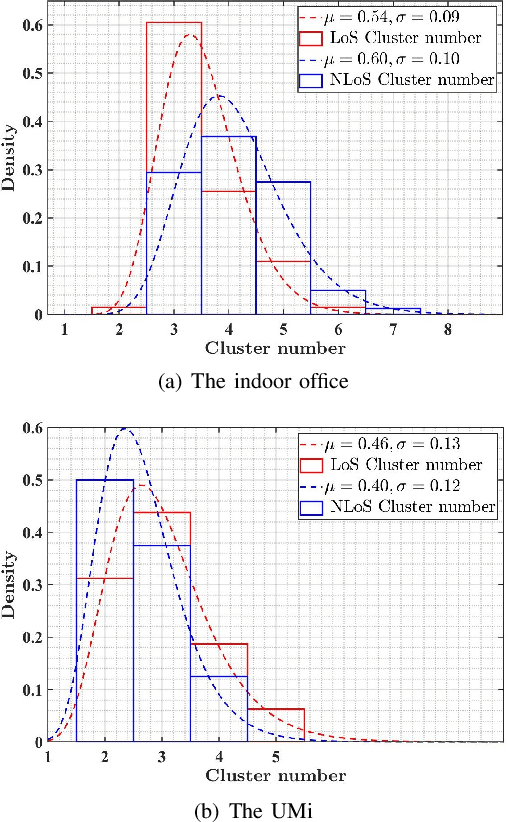
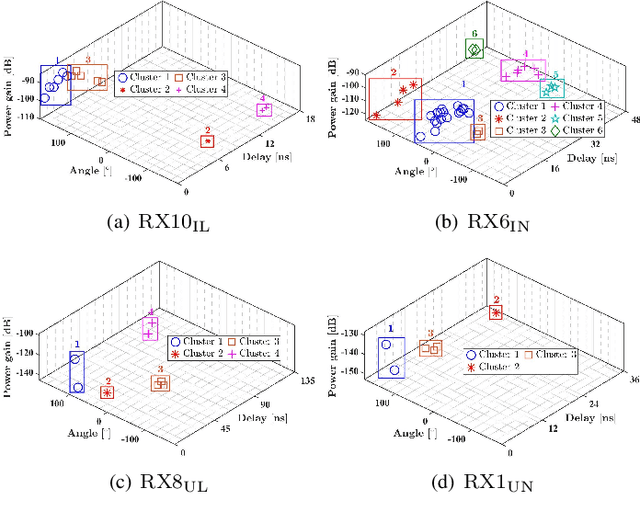
Abstract:Terahertz (THz) communication is envisioned as the possible technology for the sixth-generation (6G) communication system. THz channel propagation characteristics are the basis of designing and evaluating for THz communication system. In this paper, THz channel measurements at 100 GHz and 132 GHz are conducted in an indoor office scenario and an urban microcellular (UMi) scenario, respectively. Based on the measurement, the 3GPP-like channel parameters are extracted and analyzed. Moreover, the parameters models are available for the simulation of the channel impulse response by the geometry-based stochastic model (GBSM). Then, the comparisons between measurement-based parameter models and 3rd Generation Partnership Project (3GPP) channel models are investigated. It is observed that the case with path loss approaching free space exists in the NLoS scenario. Besides, the cluster number are 4 at LoS and 5 at NLoS in the indoor office and 4 at LoS and 3 at NLoS in the UMi, which are much less than 3GPP. The multipath component (MPC) in the THz channel distributes more simpler and more sparsely than the 3GPP millimeter wave (mm-wave) channel models. Furthermore, the ergodic capacity of mm-wave and THz are evaluated by the proposed THz GBSM implementation framework. The THz measurement model predicts the smallest capacity, indicating that high carrier frequency is limited to the single transmission mechanism of reflection and results in the reduction of cluster numbers and ergodic capacity. Generally, these results are helpful to understand and model the THz channel and apply the THz communication technique for 6G.
 Add to Chrome
Add to Chrome Add to Firefox
Add to Firefox Add to Edge
Add to Edge